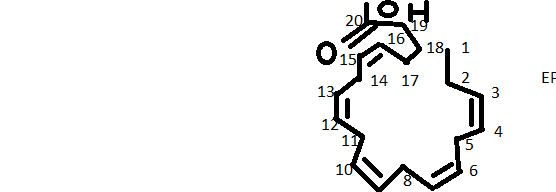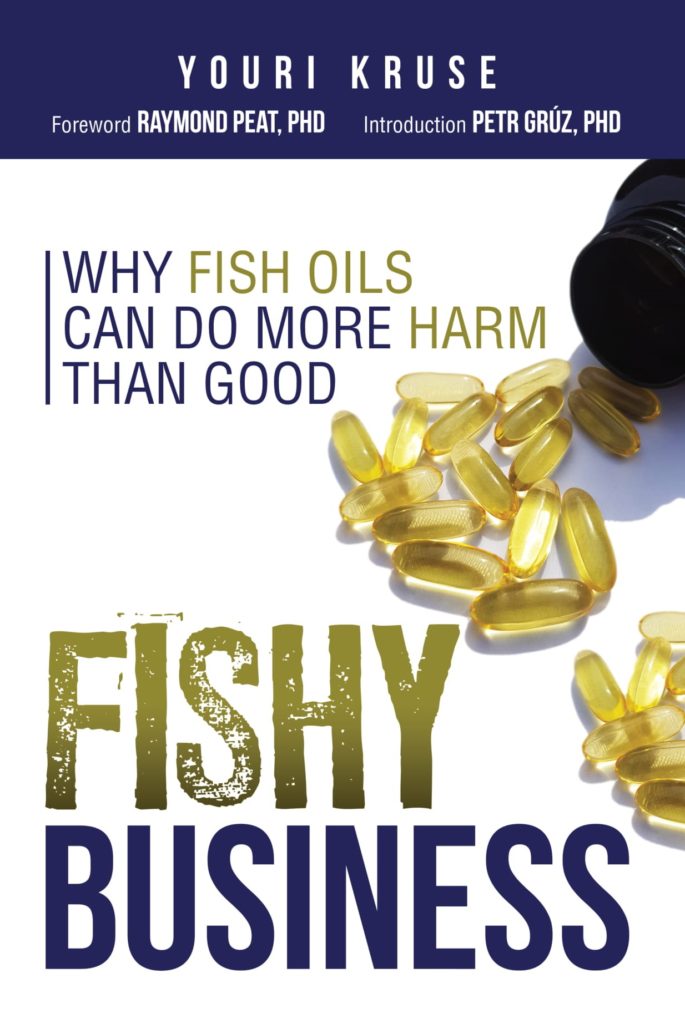Linolenic vs linoleic series
The linolenic fatty acids are the omega 3, while the linoleic fatty acids are the omega 6. These fats get their name from the last double bond at the carbon chain. At the end of a fatty acid (omega), you can count the number of carbons, if there are 3 carbons to the last double bond it’s omega 3, if there are 6 carbons it’s omega 6. Below is an example of EPA, which has 20 carbons and from the third carbon, you can see a double bond.

Because omega 3 (ALA, EPA and DHA) have more double bonds, they are actually more fragile than omega 6 (AA has 4 double bond). Because the linolenic series N-3 are more prone to turn into oxidizing products when interacting with metals than the linoleic series N-6, the capacity of antioxidants will be greatly reduced”[i].
Although it has been argued that because DHA turn into itself decreasing the process to be oxidized, overall the greater number of double bonds, the greater rate of lipid oxidation. It is also argued that a small degree of lipid oxidation is a healthy way to upregulate anti-inflammatory responses resulting in better health.
It is true that inflammation (after lipid peroxidation) upregulates enzymes like catalase and glutathione peroxidase and superoxide dismutase . After the enzymes are used up and can’t be recycled fast enough or are unable to perform their actions (by lipofuscins for example) these enzymes are unable to perform at their normal rates and reactive oxygen species and most likely aging are accelerated.
This upregulation of antioxidant gene expression by fish oil feeding is not because of some benefit to the human body, but for protection against reactive oxygen species produced by fish oil[ii].
When melonaldehydes are measured in elderly and followed it was shown that those with high melonadlehyde concentrations had almost a 500% increase in mortality than those with the lowest melonaldehyde concentration[iii].
The loss of anti-oxidant defenses and within oxygen, mineral, and pufa rich environment will likely lead to deteriorating results in the body[iv].
It has been known that fish oil is prone to damage the tissue and challenge the antioxidant system compared to saturated fats[v]

[i] Clinical and Experimental Pharmacology and Physiology (1994) 21,88 1-889. HIGH FISH OIL DIET INCREASES OXIDATIVE STRESS POTENTIAL IN MAMMARY GLAND OF SPONTANEOUSLY HYPERTENSIVE RATS. R. S. Mehta, C. A. Gunnett, S. R. Harris, 0. R. Bunce and D. K. Hartle. Department of Pharmacology and Toxicology, College of Pharmacy, University of Georgia, Athens, USA
[ii] Am J Physiol Gastrointest Liver Physiol. 2002 Feb;282(2):G338-48. Fish oil feeding alters liver gene expressions to defend against PPARalpha activation and ROS production. Takahashi M1, Tsuboyama-Kasaoka N, Nakatani T, Ishii M, Tsutsumi S, Aburatani H, Ezaki O.
[iii] Lipid peroxidation, antioxidant status and survival in institutionalised elderly: A five-year longitudinal study JOSE´ M HUERTA, SONIA GONZA´ LEZ, SERAFINA FERNA´ NDEZ, A´ NGELES. M. PATTERSON, & CRISTINA LASHERAS Departamento de Biologı´a Funcional, A´ rea de Fisiologı´a. Facultad de Medicina, Universidad de Oviedo, Julia´n Claverı´a s/n, Oviedo 33006, Spain. Accepted by Professor F. Kelly (Received 21 October 2005; in revised form 10 January 2006)
[iv] Dietary (n-3) fatty acids affect rat heart, liver and aorta protective enzyme activities and lipid peroxidation. (PMID:1880611) L’Abbé MR , Trick KD , Beare-Rogers JL The Journal of Nutrition [01 Sep 1991, 121(9):1331-1340] Journal Article
[v] Free Radic Res Commun. 1991;12-13 Pt 1:147-52. Effect of fish oil and coconut oil on antioxidant defence system and lipid peroxidation in rat liver. D’Aquino M1, Benedetti PC, Di Felice M, Gentili V, Tomassi G, Maiorino M, Ursini F.